
The taxi from the centre of Swansea brings me to this corner of Convent Street. The stone Cathedral of Gothic design looks impressive. At the West end we notice the memorial cross, the tall round tower and the small extension on the South side.
2. NEARBY VACANT LAND

We follow up Convent Street, alongside the Cathedral. After a short distance, on our right, some steps lead up to a gate through which we see a small plot of vacant land. Opposite, is a stone wall, and atop this wall a saint looks out towards the Cathedral from his small ‘guardhouse’.
3. SOUTH VIEW
From our elevated position, there is a good view of the South wall of the Cathedral. We notice particularly the complexities of the Eastern apse.
4. THE EAST END
Closer inspection feels that the Cathedral actually abuts the adjacent building at the Eastern end.
5. SOUTH WALL
This view of the South wall shows clearly where the chancel, sanctuary, and side chapels have been added to the original nave. The extension has been well done and matches the original perfectly.
6. SIGNBOARD

The blue signboard on the Southeast corner of the Cathedral gives the Cathedral name, St Joseph’s, and also the times of the various services.
7. WEST WALL
On the West side, the Cathedral is separated from Convent Street by a high stone wall. The corner tower of the Cathedral appears to be just ornamental: I can find no record of any Cathedral bells.
8. NORTH WALL
On the North side of the cathedral, and at a lower level, there is a steel gate leading through to a car park. There are two extensions on this side of the Cathedral. My guess is that the near one contains office space, and the more distant one houses confessional rooms.
9. WEST STEPS AND CROSS
We climb the steps up to the West doors. At the top of the steps there is a large Celtic cross – a memorial dedicated to those members of the parish killed in the First and Second World Wars.
11. NARTHEX
The West doors lead to a large entry porch or narthex. The base of the walls of the narthex is covered with an attractive mosaic. Between the doors hangs a framed photograph of Mother Teresa. On the South side a door leads from the narthex; this door is locked and I guess that this is the sacristy for the clergy. On the North side of the narthex is an open door which probably leads through to small meeting rooms or classrooms. The small door on this side leads to the tower and the balcony.
12. MOTHER TERESA AND MOSAIC
Mary Teresa Bojaxhiu, commonly known as Mother Teresa and honoured in the Catholic Church as Saint Teresa of Calcutta, was an Albanian-Indian Roman Catholic nun and missionary. She was born in Skopje, then part of the Kosovo Vilayet of the Ottoman Empire. After living in Skopje for eighteen years, she moved to Ireland and then to India, where she lived for most of her life. • The attractive mosaic features vine leaves and fleur-de-lys.
13. NAVE
The nave is long with a high central section and two lower side aisles. Above is a dark stained gable roof, with flat roofs over the side aisles. An unusual feature is the curved arches supporting the side aisle roofs. The Cathedral is brightly lit by the high clear clerestory windows, and the clear side windows. Two rows of Gothic arches march to the front. The columns are decorated with colourful banners, and we notice the musical angel at the top of each column.
14. NAVE ROOF
The nave roof is a simple timber structure, supported by graceful arches.
15. WEST NAVE
From the centre of the nave, we can look back to the West wall with its balcony extending back over the top of the narthex. An angel looks out from each end of the balcony. More obvious is the large pipe organ which sits on the balcony. When the original church was built in 1888, Fr Bede Cox was successful in obtaining Lord Petre’s pipe organ. The Petre family of Essex were recusants – people who adhered to the Catholic faith after the English Reformation. In 1919 the pipe organ was dismantled and rebuilt in preparation for the consecration of the Church.
16. REAR ANGELS
One of the angels carries a scroll; the other blows a horn. These are but two of a small band of musical angels in this Cathedral.
17. MUSICAL ANGELS I
The musical angels above the columns on the North side of the Cathedral play a variety of instruments including a washboard(!), cymbals, a small organ and a tambourine.
18. MUSICAL ANGELS II
The musical angels on the South side play an old variety of violin, a harp, and two horns. There are two further angels, one of whom carries a shield with the inscription ‘Quis ut Deus’ (Who is like God?).
19. BANNERS I
The interior of the nave is brightened by these colourful and wonderfully creative banners. From left we see Noah and his ark, Moses leading the children of Israel across the Red Sea, the sacrifice of Isaac, and Adam and Eve in the garden of Eden.
20. BANNERS II
These next banners show the creative power of God, rivers of living water flowing from the Temple, the creation of animals and mankind, and grain flourishing by a stream.



















